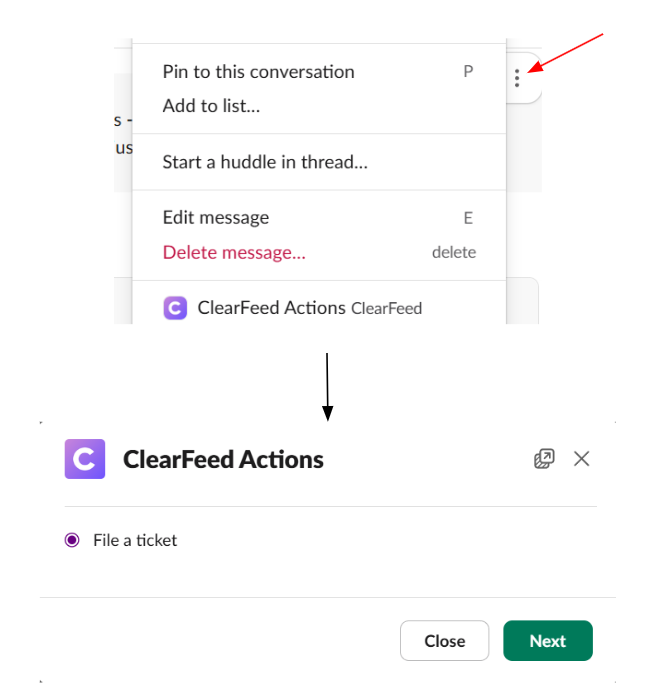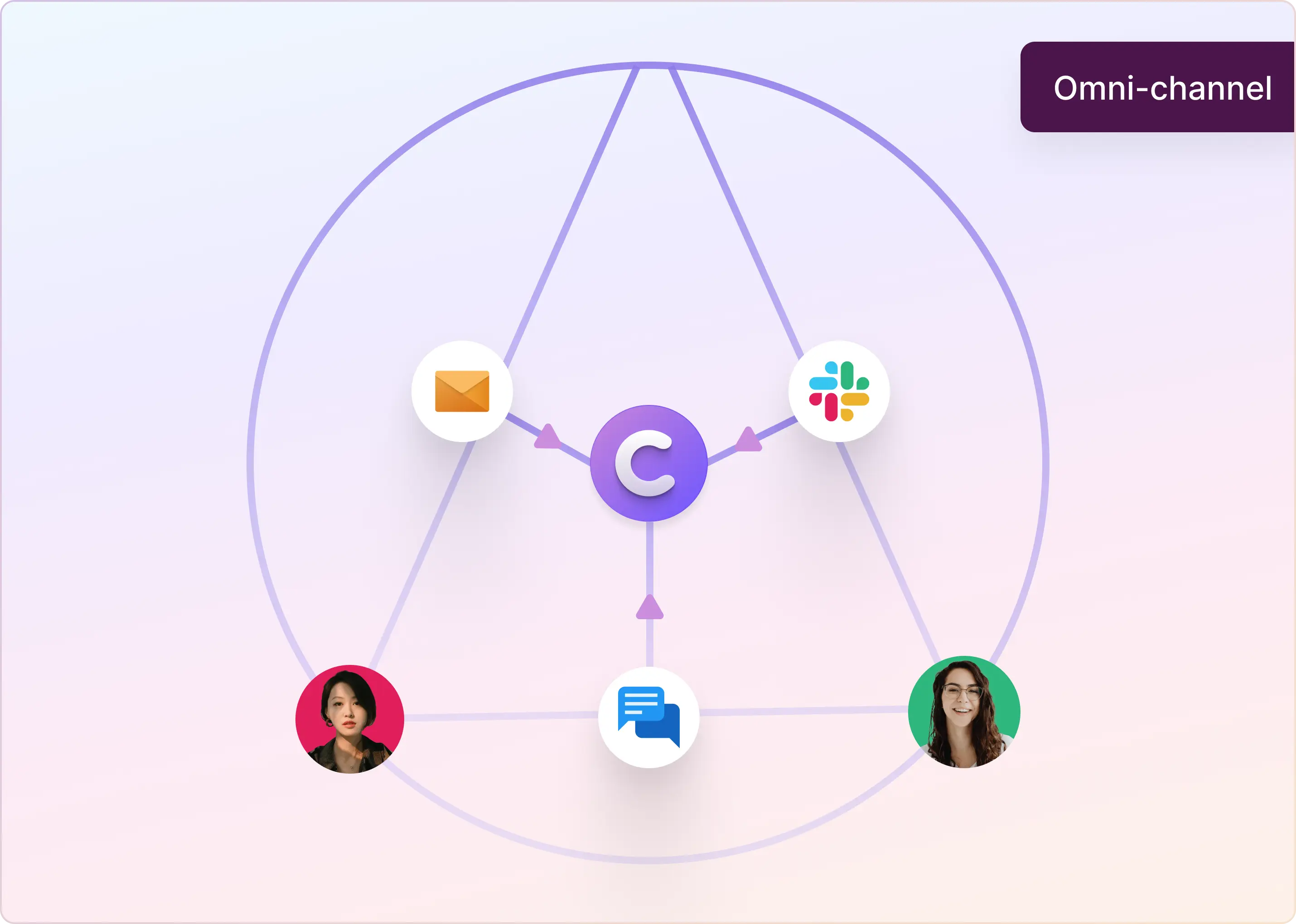You've got a powerful communication tool - Slack. Your teams are collaborating seamlessly. Your workplace is more connected than ever. So why are your employees and customers struggling with support and complaining about noise? Enter the Slack helpdesk.
It doesn't matter if you have the most advanced ticketing system if your staff have to juggle multiple platforms to get help. Don't sweat it - we're breaking down what Slack helpdesk is and how it can optimize your support operations.
Pro Tip: If you hit this blog trying to find a way to reach Slack's Customer Support - check out this Guide on how to contact Slack Support instead!
What Is a Slack Helpdesk (or Slack Service Desk) ?
A Slack helpdesk is a support system that works inside Slack. It can be defined as a centralized support solution based on slack-first communication. It lets users submit requests and get help directly within the Slack platform. It also streamlines communication and improves productivity.
Understanding Slack helpdesks is very important for modern businesses. This is especially true for companies that use remote or hybrid work models. These businesses need efficient, integrated support systems. They need a place where employees and customers can get help every day. This help can range from simple questions to complex problems. Deploying lightweight Slack helpdesks is a key strategy for managing Slack noise and chaos.
What Are Some Key Features of a Slack-Based Helpdesk?
The conversational DNA of Slack makes it a natural fit for support interactions. Users can report issues as easily as chatting with a colleague, while agents can swiftly respond and collaborate on solutions. Key features unique to Slack helpdesks include:
- Dedicated channels for different support requests (e.g., IT troubleshooting, HR inquiries, sales assistance).
- Convenient ways for users to submit support tickets (e.g., channel messages, slash commands, workflow and private actions and even direct messages).
- View and reply to tickets in Slack seamlessly.
- Slack-native workbench for Support agents (to triage, respond to, and manage tickets from within Slack—including tickets created from outside Slack (for example, via email).
- Seamless notifications in Slack for important events, like ticket resolution, assignee changes, and SLA alerts.
- Connected with knowledge bases like Notion, Confluence, and Google Drive to automatically answer questions and resolve issues reported on Slack.
- Seamless integration with existing enterprise systems like CRM (HubSpot and Salesforce), Project Management (ClickUp, Jira, and Asana), Asset Management (Kandji, JAMF), and HR (like BambooHR), so users don’t have to switch between tools.
- Reporting on key service metrics like response times and SLA breaches based on activity within Slack itself.
What Are the Use Cases of Slack Helpdesk?
Slack helpdesks can be used by almost all departments within a company—and even by external support. All employees have access to Slack, making it the natural way to get support and help from different departments. Here are some examples:
- HR can transform onboarding, leave management, and employee inquiries into smooth, transparent processes.
- IT teams can manage technical support requests, incident reporting, and knowledge sharing with unprecedented efficiency.
- B2B customer support can change how businesses connect with their customers, work well with tools they already use, and use AI to provide more thoughtful automatic replies.
- Sales can streamline lead management, track performance metrics in real time, and respond quickly to client inquiries.
- Engineering and operations can handle bug reports and feature requests and maintain a robust knowledge base for internal documentation and troubleshooting.
How Do I Compare Slack-Native Helpdesks to Email-Based or Traditional Ticketing Systems?
A Slack-native helpdesk will share many of the core functionalities of a ticketing system with traditional systems while offering unique features in how deeply integrated it is with Slack. Here are some of the common differences:
- Messages as Tickets: A Slack-native helpdesk will allow posting a simple message on a channel to create a Ticket. A good solution preserves the messaging nature of Slack, while adding the structure required by a Ticketing System.
- Two-Way Sync between Tickets & Slack: While many traditional helpdesks have Slack integration and allow ticket creation and notifications, they do not provide seamless two-way synchronization between tickets and Slack threads.
- Forms integration within Slack: Most traditional helpdesks do not have good integration of their forms within Slack, nor do they have dashboards and triage channels embedded in Slack itself for users and agents to view tickets.
- Analytics based on Slack messages: Traditional helpdesks do not measure metrics such as response times and message volume directly in Slack.
- Flexible Pricing Models: Most traditional help desks are priced based on licensed Agents. Since not all Slack users are licensed, it's challenging to collaborate seamlessly within Slack. Whereas true Slack-native helpdesks like ClearFeed offer usage-based licensing, enabling all users to collaborate freely on tickets.
- Ticketing Answer Bots in Slack: Traditional helpdesks often come with AI bots, but their experience providing automated resolution and answers within Slack is far from ideal. Slack helpdesks will have bots that chat with users within Slack on ticket creation, handing them over to humans only when they aren't able to auto-resolve.
- Omni-channel ticketing within Slack: While some Slack helpdesks do not support email ticketing, a fully-featured Slack helpdesk like ClearFeed allows the creation of email (and web chat!) based tickets in the same manner as Slack.
- Ticket Triage in Slack: Traditional Ticketing Systems have browser based interfaces for replying to and updating tickets. Modern Slack helpdesks allow Agents to respond to and manage tickets from Slack as well (eg: ClearFeed Triage Channels).
How Do Slack Native Helpdesks Handle External Support?
While Slack is commonly used by Internal Employees and most Slack helpdesks focus on handling internal support - but a good Slack helpdesk can handle external support effectively as well. Here’s how:
- Slack Connect and Guests allow external users to be part of a company’s Slack workspace. This allows Slack-native helpdesks to service requests from such external users over Slack itself.
- Using technologies like AWS SES, one can easily receive and respond to Emails from Slack itself. A great email integration built directly into Slack is a hallmark of a good Slack-native helpdesk and allows it to serve External Users.
- Similarly, technologies like Google Firebase enable the seamless exchange of messages between a server and a browser, and such backends allow Slack-native helpdesk to bridge live chat on browsers with Slack.
As a result - Slack-Native helpdesks like ClearFeed can allow Support teams to handle Support across Email, Chat, Slack, Teams - all from Slack. And they can setup a combination of external and internal helpdesks (for example - internal support desks are often required to allow internal employees to report problems on behalf of customers).
What Criteria Should I Use To Evaluate a Slack-Native Helpdesk Platform?
While every organization has a different set of criteria that fits its use case, here’s a list of common questions to ask while evaluating a Slack-native helpdesk:
- Does the solution support manual and automatic ticket creation from Slack channels, including private channels?
- Does it allow creating tickets privately—whether via shortcuts or private actions?
- Can it integrate non-Slack communication channels like Email and Live Chat if required?
- Is it integrated with knowledge sources and allows deflection of queries right within Slack?
- Does it have an excellent forms implementation within Slack to collect structured data from users?
- Does the solution allow seamless responses from agents within Slack (such as from a Triage channel) without switching tools? Does it give Agents dashboards to look at the overall state of tickets using constructs like Kanban Boards for example?
- Similarly - do employees and customers get a dashboard from where they can see all reported tickets?
- Does it integrate with existing enterprise software within my company, such as CRM, Project Management, HRIS, and Asset Management systems?
- Does the solution have strong alerting and notification functionality in Slack to keep issues that need attention in focus?
- Can I implement standard workflows like approvals and escalations - everything within Slack?
- Do the service metrics provided by the solution cover responses within Slack and automatically distinguish between agent and customer/employee responses?
- Given that Slack has all kinds of data, does the solution allow fine-grained control over what data is stored in the Slack-native helpdesk? Is it SOC2 or ISO27001 certified with strong controls over data storage and retention?
These questions go above and beyond what one might expect from any ticketing solution (such as the ability to route tickets, manage assignees and shifts, manage business schedules, etc.).
How Can We Turn Slack Into a Fully-Functional IT Support and HR Helpdesk?
You can turn Slack into a modern IT or HR helpdesk by using a modern IT helpdesk software and ticketing system built for teams working from Slack. Unfortunately, while Slack has many valuable features like emojis, channels, private messages, reminders, canvas, workflows, and now even Slack lists, it falls short on its own as a fully functional IT or HR helpdesk.
Key missing features include the ability to track response times, sync lists and threads, file private tickets, and enable in-built automated answering from knowledge bases, etc. To build a modern service desk in Slack:
- Pick a ticketing vendor like Jira Service Management (and Atlassian Assist), Linear Asks, Freshservice, or ClearFeed.
- Install the corresponding app in your Slack Workspace.
- Designate specific channels for each team to file tickets.
- Set up private ticketing via the app for creating tickets privately (essential for HR!)
- Set up forms and queues for structured ticket handling and routing, with notifications and triage channels (preferably) for each queue within Slack.
- Setup an Answer Bot to assist users with common questions by automatically responding from company documents. Examples of such apps include Rovo by Atlassian and ClearFeed's AI Agents.
- Integrate with key ITSM and HR tools such as Okta and BambooHR and setup automated actions in those systems.
How Can Support Teams Manage SLAs and Ticket Routing Directly Within Slack Workspaces?
Support teams can manage SLAs and ticket routing in Slack by layering structured workflows on top of conversations. A few specific mechanisms:
- SLA tracking: Every request in a Slack thread can be converted into a tracked ticket with timestamps. SLA timers run in the background, and when thresholds are close to being breached, the thread is flagged or escalated in Slack.
- Routing logic: Tickets created from Slack messages can be automatically routed to the right agent or channel based on keywords, forms, AI prompts, customer priority, and other custom rules.
- Assignment flows: Agents can claim ownership with a single click in-thread, or tickets can be auto-assigned based on workload, with Slack notifications being generated on assignee changes.
- Notifications: Approaching SLA breaches or routing updates are pushed into Slack threads or team channels, so nothing is missed.
A specialized Slack helpdesk like ClearFeed can help implement SLAs and routing within Slack.
Can Support Teams Manage Approvals, Workflows, and Escalations Directly in Slack?
Yes absolutely. Slack provides a powerful platform with notifications, forms, and interactive widgets within messages, as well as APIs that allow people to build powerful workflows. Using these Slack-native help desks, we have built end-to-end Workflows for use cases like approvals. As an example, an approval chain may look as follows:
- User posts a message on a channel.
- A ticket is created, and the user is asked to fill out a form.
- Based on the submitted form, an approval flow is automatically started.
- The approval flow results in the user’s manager being sent an approval request.
- With the manager's approval, the service team can now perform the requested action and close the ticket.
Such approval workflows are available in Slack-native helpdesks like ClearFeed.
Can Employees Request Tech Support and File Tickets Directly in Slack?
Yes! If your Ticketing Solution offers a good Slack integration, employees should be able to simply message for support in Slack - and the system should automatically create tickets and provide a seamless sync between the created Ticket and Slack thread. Here are some of the typical mechanisms Support teams roll out for employees:
- Designate Request Channels in Slack: Drop a message in such channels to create a ticket.
- Workflow Actions in Slack: Create workflow actions and pin to specific channels to create tickets with Forms.
- Use Short-Cuts: Slack Short-Cuts provided by the Ticketing vendor (eg: /jira-create by Jira and /cf-file by ClearFeed) to initiate ticket creation.
- Use Ticketing App Home Page: Ticketing Solutions may provide a Slack App that has File Ticket buttons inside the App.
- Use Slack Message Actions: If users direct message support requests to Agents, Ticketing solution may allow conversion of such messages to Tickets via Slack message Actions.
Here's how the File Ticket button in ClearFeed Slack App looks like for example.

And how to use Slack Message Actions to start a File Ticket flow:

Can I Set Up a Helpdesk for Internal Support That Works Entirely Inside Slack?
Yes - absolutely! Support teams can manage internal support without leaving Slack, by using a Slack-native helpdesk. Traditional Helpdesk and Service Desk systems do not allow Agents to manage Tickets from within Slack. While they may have good Slack integrations for sending notifications and alerts - Agents are expected to work out of browser-based Apps. However modern Slack helpdesks like Halp (now Atlassian Assist) and ClearFeed have Triage channels in Slack from where Agents can monitor all incoming tickets, update statuses and fields, post public and private replies, tag colleagues for collaboration. It is now possible to even build Kanban dashboard of Tickets in Slack - thanks to Slack Lists! Here's how a Ticket Dashboard in Slack looks like with ClearFeed:
.jpg)
What Are Some Features That Distinguish Slack Helpdesk Apps From General Slack Integrations?
Most existing ticketing, task management, and project management systems have integrations with Slack. While the differences vary by the specific integration, here are some general differences:
- Integrations allow creating tickets and tasks, but do not provide two-way syncing between Slack and external tools.
- Most integrations do not provide automated conversion of messages to tickets or tasks, or entries in external systems.
- Applications advertising Slack integrations force users (particularly Agents) to switch between Slack and their own app. They are not designed to let people work entirely in Slack.
- Each application builds its own integrations, but a Slack helpdesk integrates with multiple applications from a single workbench, allowing users to work seamlessly across tools that any single integration ever can.
How can we maintain Slack Message Threading in a Helpdesk?
A common problem when using Slack as a helpdesk is that users post multiple top-level messages to describe their problem. This creates noise in the channel and also conversation about the issue gets scattered. The best way to solve this problem is to auto-respond in Slack when users post queries and to create a thread automatically. This prompts users to post subsequent updates on the same issue on the newly created thread. Here are some ways in which to accomplish this:
- Setup a Slack Answer Bot - and post automated answer or an acknowledgement on the thread as an auto-response.
- Create Tickets and post Ticket details in Slack thread automatically.
With Slack Helpdesk solutions like ClearFeed - you can achieve one or other, or even combine both. AI Agents in ClearFeed can automatically answer questions - and/or - create a ticket and post the ticket message on Slack with some ticket details. It also supports flows where the ticket is only created if the automated answer is not useful. ClearFeed can create tickets in many external systems like Jira, Zendesk, ClickUp, Linear - or create a ticket in ClearFeed itself. Ticketing vendors have their own Slack integrations - but few (except Linear Asks) - will create tickets automatically on every query.
What Are the Best Slack Helpdesk Tools and Apps?
There are a number of legacy helpdesk tools with strong Slack and CRM integrations and modern helpdesk platforms built specifically for the age of Slack and AI. Some examples include:
- Jira Service Management (JSM): A well-known helpdesk software, with a rich set of features (at the cost of complexity). JSM has an excellent Slack integration via Atlassian Assist (though it can cost quite a bit more).
- Freshservice: A popular choice for entry-level ITSM service desks with a good Slack integration. While it has excellent two-way synchronization with Slack, it doesn’t allow agents to respond from within Slack.
- Linear Asks: One of the more modern tools and a cross-over from Linear’s excellent project management system. Allows seamless creation of Tickets from Slack, but is limited in its ability to handle customer support use cases, limited service metrics ,and email integration and also forces agents to use Linear for replies.
- ClearFeed: A modern helpdesk built for Slack, letting users and agents create and reply to tickets all from within Slack, while being able to handle tickets across emails and live chat as well, with excellent built-in AI auto-resolution functionality.
Which Slack Helpdesk Integrations Work Best for B2B Companies Scaling Support Operations?
Many customer support ticketing systems integrate with Slack. B2B firms can choose from mature offerings with strong Slack integrations or from modern ones built for teams working in Slack. Here’s a quick shortlist:
- Intercom: A well-known support ticketing solution, known for its excellent web chat widget and Fin AI solution, now has a refreshed bi-directional sync with Slack. However, Intercom can be expensive, pulls agents back to Intercom to respond to tickets ,and is not meant for collaborative Support with a large number of employees acting as Agents.
- Front: A well-known solution for implementing shared inboxes over email now also offers a good Slack integration. It sends notifications for new tickets and syncs conversations from customer Slack chatrooms to Front. However, like many older tools, Front forces agents to respond from the Front app (and not from Slack), and the pricing is not designed for large collaborative support teams.
- ClearFeed: A modern omnichannel help desk built for teams who love working out of Slack. Offers unlimited agent pricing, so the entire team can work unhindered with customer,s and brings emails, live chat, Slack, MS Teams,and support portal - all into one place in Slack. As a new solution, it may lack depth of features like complex assignment policies, for example.
How Can We Measure Helpdesk Performance Inside Slack?
Even within Slack, you can measure helpdesk performance by turning conversations into trackable tickets and applying metrics to them. Key approaches include:
- Ticket volume and throughput: Count the number of tickets created, resolved, or pending over a given time frame.
- Response times: Track time from ticket creation to first response in the thread.
- Resolution times: Measure how long it takes to resolve requests fully.
- SLA compliance: Monitor tickets against defined SLA thresholds and flag breaches.
- Assignment efficiency: Track how quickly tickets are assigned to the right agent or team.
- Escalation rates: Identify tickets that require multiple handoffs or reach senior staff.
- Customer feedback: Collect ratings or comments directly in Slack threads after resolution.
All of these can be automated with a Slack-based helpdesk like ClearFeed that continually monitors Slack channels and threads, records the timestamp of every response and action on the ticket, and provides insights and digests based on the same.
What Are Some Limitations of Using Slack as a Helpdesk?
While Slack is great for quick collaboration, it has some fundamental limitations when used as a primary support channel:
- Lack of structure: Requests arrive as free-form messages and can easily get buried in threads. They also arrive as direct messages which are even harder to track down.
- Poor tracking and analytics: Slack doesn’t natively support ticket states, SLAs, or response-time reporting.
- Scaling issues: As volumes grow, it becomes hard to prioritize, assign ownership, or manage queues.
- Limited workflows: Approvals, escalations, and routing require manual effort or external tools.
- Data management: Slack isn’t designed for long-term record-keeping, auditing, or analytics.
- Context switching: Without integrations, agents must copy information into helpdesks or CRMs, which risks errors and delays.
- Permissions and visibility: Sensitive customer data may be exposed more broadly than intended if channels aren’t carefully managed.
- Managing large numbers of channels: In Customer Support use cases, channel counts can proliferate with some Support teams reporting 100s of channels. This can make it challenging to keep track of channels to monitor/delete or to assign ownership of.
- Limited Support for Emails and other channels: Inevitably some customers and employees need support beyond Slack. Live Chat is a must for Customer Support. Slack does not have native support for these mediums.
These gaps mean most teams need a structured helpdesk layer on top of Slack to handle support at scale.
Slack + ClearFeed: How We’re Optimizing Support Operations
ClearFeed's mission is to transform Slack into a smooth support powerhouse. With over 50 percent of its features powered by AI, ClearFeed empowers support teams to better understand their employees and customers, predict issues before they arise, and personalize responses at scale. And all within Slack.
Users simply interact with employees and customers in Slack, and ClearFeed automatically generates and manages tickets for them. When it's time to respond to a query, ClearFeed's AI draws from past interactions, best practices, and real-time data to suggest responses that resonate with customers and improve resolution rates.
Want to know more about how we can help you scale support operations? Get in touch with us here.
Other Frequently Asked Questions
1. What's the typical pricing range for Slack-native helpdesk tools?
Pricing varies. On some platforms, a minimal subscription costs as low as $7/month/agent, while on others it can cost as much as $80. Watch out for licenses that look cheap but do not include critical functionality, such as basic AI services. While most vendors offer agent vendors, a few like ClearFeed offer usage-based pricing with Unlimited Agents.
2. What Security and Privacy Features Should a Slack Helpdesk Include?
A Slack helpdesk should have security built in at multiple layers to protect customer and employee data and company workflows. Key features include:
- Granular permissions/Role-based access: Control who can create, view, and respond to tickets in Slack.
- Data access controls: Ensure customer and employee data is only visible to authorized users.
- Audit logs: Track all actions on tickets and approvals for compliance and troubleshooting.
- Encryption: End-to-end encryption for data in transit and at rest, aligned with Slack’s enterprise security standards.
- SSO and SCIM support: Integrate with identity providers for secure logins and automated user lifecycle management.
- Data retention & redaction policies: Respect the company's retention settings and allow configurable data retention. Redact security sensitive data like passwords from tickets.
- App review and scopes: Limit Slack app permissions to the minimum required for operation.
These mechanisms ensure the helpdesk runs smoothly in Slack without compromising on enterprise-grade security.


















